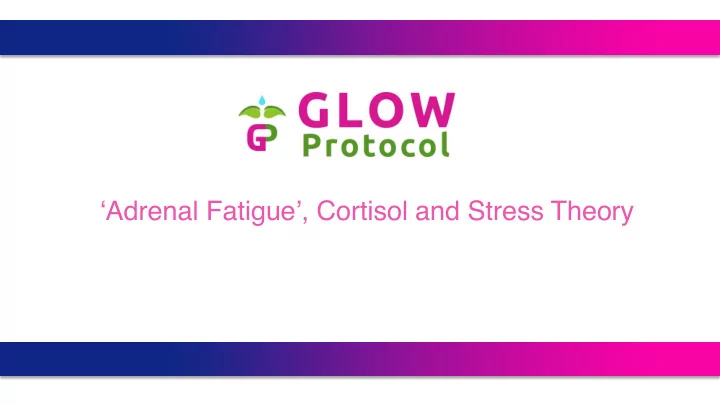

‘Adrenal Fatigue’, Cortisol and Stress Theory
Sex Hormone Review
ESTROGEN, PROGESTERONE, TESTOSTERONE Women make estrogen in the ovaries and fat cells Progesterone is made by the corpus luteum during ovulation Testosterone is made by the ovaries and adrenal glands In men, testosterone is made by the testes
Adrenal Hormones
CORTISOL The hormone that helps buffer stress DHEA-made in the adrenals and the brain Helps to counteract the catabolic effects of cortisol CLINICAL PEARL: High amounts of insulin cause women to make more testosterone & men to make more estrogen.
The Hormone Cascade
The Hormone Cascade An extremely over simplified way of looking at steroidogenesis Cholesterol Pregnenolone Progesterone DHEA Androstenedione Estrone Estriol Aldosterone Pregnenolone Steal? Testosterone Estradiol Cortisol
Adrenal Glands
What are the adrenal and what do they do? glands? Adrenals are a pair of glands that sit atop the kidneys Comprised of 2 very different parts: Cortex & Medulla Cortex contains 3 zones of cells: 1. Zona glomerulosa (produces aldosterone) 2. Zona fasciculate (cortisol) 3. Zona reticularis (DHEA) The adrenal medulla produces epinephrine & norepinephrine (adrenaline & noradrenaline)
Cortisol
UNDERSTANDING CORTISOL Cortisol is a steroid hormone 95% of cortisol is bound to protein carriers Secreted in a diurnal rhythm Controlled by HPAAxis Has 3 main functions: 1. Raise blood pressure 2. Raise blood sugar 3. Modulate inflammation Aids in digestion, helps metabolize protein, fat and carbs and regulates blood pressure
Circadian Rhythm
What is the Circadian Rhythm? • Our 24 hour clock • Humans are diurnal • Cortisol is secreted in a diurnal fashion • It is highest in the morning • Lowest at night • Cortisol and melatonin oppose each other Cortisol B (Morning) Within range 73.9 ng/mg 38 - 120 Cortisol C (Afternoon) Low end of range 8.5 ng/mg 7.3 – 21 Cortisol D (Night) Within range 3.0 ng/mg 0 - 10
GETTING SUN IS NOT JUST ABOUT VITAMIN D Sunlight in the eyes transmits to a small bundle of neurons in the hypothalamus This controls the SCN The SCN causes the hypothalamus to release CRH The CRH causes the pituitary to release ACTH causing the adrenals to make and release cortisol
High Cortisol Symptoms What it Feels Like • High blood pressure 1. Frequently stressed out • High blood sugar 2. Trouble falling asleep • Insulin resistance 3. Anxiety and irritability • Cravings for carbs 4. High blood sugar levels • Tired but wired feeling 5. Waking up tired • Anxiety, depression 6. Sweaty often • Increased belly fat • Frequent infections • Easily bruise • Poor wound healing • Decreased muscle mass
Low Cortisol Symptoms What it Feels Like • Fatigue 1. Trouble staying asleep • Inflammation 2. Being a slow starter in the morning • Pain 3. Afternoon fatigue • Allergies 4. Feeling run down • Muscle weakness 5. Often overwhelmed • Low blood pressure 6. Cravings for salt and sweets • Low blood sugar • Poor stress handling 7. Postural hypotension • Brain fog 8. Afternoon headaches • Depression • Low libido
Is it Adrenal Fatigue Dysfunction?
THE HISTORY OF STRESS THEORY Hungarian endocrinologist Hans Selye coined the word stress in 1936. He defined it as “the non specific response of the body to any demand made upon it.” In 1950, he introduced the “general adaptation syndrome”
THE HOLISTIC PRACTITIONERS PARADIGM Stage 1: ACUTE PHASE Stage 2: COMPENSATORY PHASE Stage 3: EXHAUSTION PHASE
Is this paradigm accurate? Saliva testing only measures cortisol availability. ? Adrenal fatigue has been the dominant way of understanding chronic fatigue and other related health issues for a long time in the alternative medicine community but fresh thinking by new researchers is discovering that this is vastly oversimplified. Both cortisol production and availability must be measured to determine the function of the HPAaxis.
Stress Response is Good ? The stress response and cortisol are good things. They are meant to keep us alive in the face of a threat to our well being. But we not meant to handle constant stressors. When stress remains constant, the body goes into an adaptive state and may choose to lower cortisol output to protect tissues from the damaging effects of long term high cortisol, which is catabolic.
So, if it’s not adrenal fatigue, then what is it? ? So, while it is not adrenal fatigue, there certainly is something else going on if you are dealing with symptoms discussed previously. Lab testing is only a part of an evaluation. Sometimes hormone levels are tissue specific and this cannot be determined from a lab test.
BIG QUESTION TO ASK: Do you have risk factors for HPA Axis dysfunction?
Some big ones are shift work, divorce issues, poor diet, lack of down time, head trauma, injuries, drug use.
Take the adrenal health self assessment in this module and take care of those adrenals!!!
Recommend
More recommend